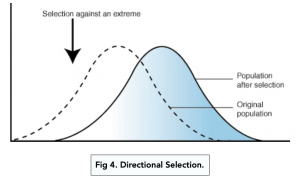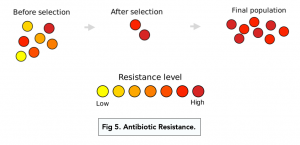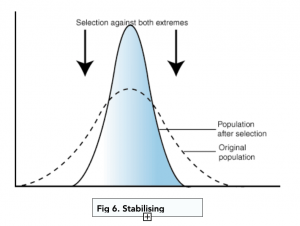Types of Selection (A-level Biology)
Types of Selection
Trends in Natural Selection
Directional Selection
In directional selection, the alleles of an extreme type are selected for. For example, bacteria gaining antibiotic resistance:
- A few bacteria have resistance. Most of the population of bacteria suffer against antibiotics. But a few in the population have alleles that give them resistance.
- A selection pressure is applied. When antibiotics are given, a selection pressure is applied. The alleles giving antibiotic resistance are selected for.
- The resistance alleles are selected for. The resistant bacteria are more likely to survive and pass on their resistance alleles to the next generation
- Bacteria evolve to become resistant. Over many generations, the bacteria evolve to become resistant.


Stabilising Selection
In stabilising selection, the alleles of the mean / middle range are selected for. This happens when the environment is stable, and the genetic diversity in a population decreases. For example, human birth weight undergoes stabilising selection.
- Human birth weight can vary. The weight of a baby can, of course, vary. But most babies have a weight in the middle range.
- A normal birth weight is beneficial. Having too small or large birth weight can make it hard to survive. So a normal birth weight is selected for.
- Natural selection keeps birth weights in the middle range. Natural selection stabilises the birth weights.

Genetic Drift
In genetic drift, the alleles are passed on by random chance. It is easier to see the effect of genetic drift within a small population.
- Benefit or harm of an allele does not affect genetic drift. In genetic drift, certain alleles are passed on more often simply by chance. This means that benefit or harm of an allele does not impact on whether it is passed on or not.
- Small populations are affected by genetic drift. As genetic drift is due to chance, it is easier to see the effects within a small population, for example in a population of 50 versus a population of 50,000.
- Certain genes become more common by chance. As we know, in genetic drift certain alleles are passed on by chance. This means that over time, these alleles will become more common in the population.
Genetic Bottleneck
When the size of a population is dramatically reduced very suddenly, this is called a genetic bottleneck. To create a genetic bottleneck, a disaster such as an earthquake must wipe out the population, leaving very few survivors.
- A large proportion of the population is wiped out. Let’s take the example of a bird population, the majority with straight beaks and a few with curved beaks. A natural disaster occurs and wipes out the majority of this bird population.
- The survivors are a random assortment of the population. After the disaster, the will only be a few bird survivors. These survivors will be a random assortment of the original population. In our example, the survivors group is predominantly made up of birds with curved beaks.
- This is an extreme version of genetic drift. Within our surviving group of birds, the majority have curved beaks. This is different to the original population, where the majority had straight beaks.
- A ‘new’ predominant allele will emerge. Due to the shift in allele proportions, there will be a more predominant allele in the group. The new predominant allele in our survivors group is the one for curved beaks.
- The predominant allele will pass on. As the survivor’s population is much smaller in size, the predominant allele will pass on. Due to the effects of the genetic bottleneck, this allele becomes more common in the population. So in our example, the birds will pass on the allele for curved beaks.
Founder Effect
Instead of a natural disaster like an earthquake, the founder effect occurs when a small proportion break away from a much larger population.
- A small proportion of the population move away. For the founder effect to begin, a few individuals from the original population move away and are reproductively isolated from the main group.
- The small group are a random assortment of the population. The individuals in the small group are a random assortment of the original population. This is an extreme version of genetic drift.
- A ‘new’ predominant allele will emerge. Due to the shift in allele proportions, there will be a more predominant allele in the group. This predominant allele will therefore be passed on, and become more common within the population.
Natural Selection and Adaptation
- Natural selection results in species that are better adapted to their environment. Species with beneficial alleles are more likely to survive, reproduce and pass on their alleles to the next generation. Members of the next generation with beneficial alleles are then also more likely to survive, so the frequency of the beneficial alleles within the population increases.
- Natural selection means that species with disadvantageous alleles are less likely to survive and reproduce. For example, a prey animal with a mutation that results in shorter legs is less likely to survive because they cannot run as fast as other prey. They are likely to be eaten by a predator, which means that their disadvantageous allele is not passed onto the next generation as they did not reproduce. The allele dies out.
- Natural selection and adaptation result in evolution. They also help to explain the diversity of life on Earth.
The beneficial adaptations that result from natural selection may be anatomical, physiological or behavioural:
- Anatomical adaptations are physical features of an organism that help them to survive, such as the long neck of giraffe which helps it to reach leaves growing on tall trees.
- Physiological adaptations are internal body functions that help an organism to survive, such as an animal that lives in a cold climate being warm-blooded.
- Behavioural adaptations are things that an organism does to survive, such as birds migrating to the south in the winter because there is more food there.
You might be asked to unfamiliar information to explain how selection produces changes within a population of a species. In order to answer these questions, you should:
- Describe what the data shows (the change within the population). Data is usually displayed as either a table or graph. To get the full number of marks available you should used figures from the data and state the type of selection that is occurring.
- Explain how selection could have caused these changes. You will need to write about the points. Don’t forget to explain that species with beneficial alleles are more likely to survive, reproduce and pass on their alleles to the next generation and why this results in changes to a population.
FAQs
There are three main types of selection in biology: natural selection, artificial selection, and sexual selection. Each type of selection plays a role in shaping the evolution of a species.
Natural selection is a process that occurs in nature where individuals with advantageous traits are more likely to survive and reproduce, passing on those traits to their offspring. Over time, this results in a change in the frequency of these traits in a population.
Artificial selection is a type of selection that occurs when humans actively choose which individuals to breed based on desirable traits. This process is often used in agriculture to produce crops and animals with specific characteristics.
Sexual selection is a type of selection that occurs when individuals choose mates based on certain traits, such as size, color, or song. These traits are often related to mating success, and over time, can become more prevalent in a population.
Each type of selection plays a role in shaping the evolution of a species. Natural selection eliminates individuals with harmful traits and allows advantageous traits to persist. Artificial selection allows humans to actively choose which traits to promote or eliminate. Sexual selection results in the evolution of traits that are preferred by mates. When these types of selection interact, they can lead to complex patterns of evolution that shape the diversity of life on earth.
Understanding the different types of selection helps us to better understand how evolution works. By recognizing the mechanisms of natural, artificial, and sexual selection, we can see how different factors can shape the evolution of a species over time. This knowledge also allows us to make informed decisions about how we interact with and influence the natural world.






Still got a question? Leave a comment
Leave a comment